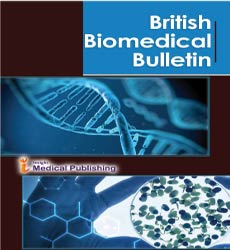ISSN : 2347-5447
British Biomedical Bulletin
Minimally Invasive Liver Resection in Cirrhosis
Sun Vivian*
1Department of Health Services Administration, China Medical University, Taichung, Taiwan
- *Corresponding Author:
- Sun Vivian,
Department of Health Services Administration, China Medical University, Taichung, Taiwan
E-mail: vivan_s@med.tw
Received date: November 13, 2024, Manuscript No. IPBBB-24-20036; Editor assigned date: November 18, 2024, PreQC No. IPBBB-24-20036 (PQ); Reviewed date: December 02, 2024, QC No. IPBBB-24-20036; Revised date: December 09, 2024, Manuscript No. IPBBB-24-20036 (R); Published date: December 16, 2024, DOI: 10.36648/2347-5447.12.4.73
Citation: Vivian S (2024) Minimally Invasive Liver Resection in Cirrhosis. Br Biomed Bull Vol.12 No.4: 73.
Description
Minimally Invasive Liver Resection (MILR) has seen a growing acceptance in recent years, mainly due to its well-documented short-term advantages, such as decreased blood loss, fewer postoperative complications and shorter hospitalization periods. Furthermore, the oncologic results in MILR have been reported to be comparable to traditional open liver resections. Nevertheless, despite its bene its, MILR continues to be a technically challenging procedure that demands a high degree of skill in both liver surgery and minimally invasive techniques. To guarantee patient safety, multiple guidelines stress the necessity of a stepwise approach to mastering MILR, underscoring the need for surgeons to progress along the learning curve. Consequently, Difficulty Scoring Systems (DSS) have been created to objectively evaluate the complexity of liver resections, assisting in case selection, risk counseling and the assessment of surgical outcomes. Liver Cirrhosis (LC), a prevalent background condition in individuals with primary liver cancers, presents additional challenges in liver resection. The cirrhotic liver is generally stiffer and more challenging to transect and patients suffering from cirrhosis o ten exhibit additional risk factors such as portal hypertension, thrombocytopenia and coagulopathy. These elements greatly elevate the risk of hemorrhage and postoperative complications, including posthepatectomy liver failure and mortality. A multicenter investigation recently validated that cirrhosis negatively impacts the outcomes of Laparoscopic Liver Resections (LLR), which is not surprising given the heightened surgical difficulty linked with cirrhotic liver parenchyma. Despite the acknowledged effect of cirrhosis on LLR results, none of the current DSS speci ically addresses cirrhosis or portal hypertension in their scoring frameworks. For instance, the Iwate score attributes only one difficulty point for Child-Pugh B cirrhosis but does not consider the existence of Child-Pugh A cirrhosis.
Cirrhosis
Prior investigations examining the effects of cirrhosis on LLR outcomes have yielded mixed findings. Some studies encompassed all types and extents of LLR, potentially complicating the results due to the inclusion of both straightforward and intricate resections alongside varied pathologies, such as liver metastases and benign tumors. Other research has indicated that the effect of cirrhosis might be contingent on the complexity of the resection. Speci ically, cirrhosis was found to lead to worse outcomes for more intricate resections but had a less signi icant impact on simpler resections. Taking these limitations into account, we carried out a matched-controlled study to speci ically examine the in luence of cirrhosis and portal hypertension on the difficulty of MILR, concentrating on patients undergoing minor resections in the anterolateral liver segments. The aim was to evaluate whether the severity of cirrhosis, in addition to the presence of portal hypertension, should be integrated into existing DSS for more precise preoperative strati ication.
Liver resections
Minor liver resections, including wedge resections and segmentectomies in the anterolateral segments, are typically regarded as the easiest forms of liver resections using both traditional and minimally invasive methods. Current DSS, such as the Ban DSS and the Iwate criteria, allocate fewer difficulty points to lesions located in these super icial, anterolateral segments. Likewise, the Hasegawa score provides lower scores (0 points) for lesions in segments 2/3/4 when compared to those in segments 5/6 (1 point) and 7/8 (2 points). The Southampton score also assigns 0 points to lesions in the anterolateral segments. Despite these recognized classi ications, the effects of cirrhosis and portal hypertension have not been sufficiently integrated into these frameworks. The results of our study emphasize the necessity for updating current DSS to encompass the presence of cirrhosis and portal hypertension, as these variables are essential in determining the intricacy and risks related to liver resections. Cirrhosis, particularly when classi ied as Child-Pugh B, substantially in luences the difficulty of MILR and may lead to worse outcomes, such as a heightened risk of postoperative complications and extended recovery periods. These results correspond with earlier research that has indicated the severity of cirrhosis is a vital factor in determining the surgical difficulty and results of liver resections.
Conclusion
In conclusion, although minor resections in the anterolateral liver segments are frequently viewed as less complicated, cirrhosis and portal hypertension present substantial challenges that must be taken into account during preoperative planning and surgical risk evaluation. The integration of cirrhosis severity and portal hypertension into existing DSS may enhance the precision of preoperative evaluations, direct case selection and improve patient counseling. This study highlights the significance of refining current DSS to guarantee that the complexity of liver resections in individuals with cirrhosis is properly addressed.
Open Access Journals
- Aquaculture & Veterinary Science
- Chemistry & Chemical Sciences
- Clinical Sciences
- Engineering
- General Science
- Genetics & Molecular Biology
- Health Care & Nursing
- Immunology & Microbiology
- Materials Science
- Mathematics & Physics
- Medical Sciences
- Neurology & Psychiatry
- Oncology & Cancer Science
- Pharmaceutical Sciences
